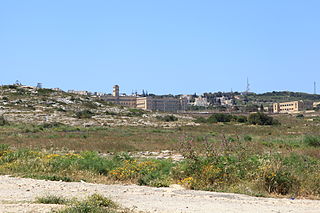
Pembroke is a town in the Northern Region of Malta, and it is considered to be the country's newest town. To the east is Paceville, the nightlife district of Malta. The coastal town and tourist hub of St. Julian's lies to the southeast, and the residential area of Swieqi lies to the south. The hilltop village of Madliena is to its west, and Baħar iċ-Ċagħaq lies to the northwest.

Fort Leonardo, also known as Fort San Leonardo or Fort San Anard, is a polygonal fort in Żabbar, Malta. It was built between 1872 and 1878 by the British between the villages of San Leonardo and Żonqor above the shore east of Grand Harbour.

Fort Delimara is a polygonal fort in Marsaxlokk, Malta. It was built between 1876 and 1888 by the British as part of a chain of fortifications intended to protect Marsaxlokk Harbour. Today, the fort is still intact but is in need of restoration, and is in danger of collapse due to coastal erosion.

Madliena Tower, originally known as Torre della Paulina, is a small watchtower in Madliena, limits of Pembroke, Malta. It was completed in 1658 as the fourth of the De Redin towers. The British built an artillery battery next to the tower in 1908–1909, and the tower and battery remained in use until World War II. Today, the battery no longer exists but the tower is in good condition.

The Victoria Lines, originally known as the North West Front are a line of fortifications that spans 12 kilometres along the width of Malta, dividing the north of the island from the more heavily populated south.

Service Children's Education (SCE) is an organisation of the United Kingdom government responsible for the education of the children of British Armed Forces families and Ministry of Defence (MoD) personnel serving outside of the United Kingdom. They provide schools and educational support services from Foundation Stage through to sixth form. They are headquartered at Trenchard Lines, Upavon, Wiltshire.

Fort Tigné is a polygonal fort in Tigné Point, Sliema, Malta. It was built by the Order of Saint John between 1793 and 1795 to protect the entrance to Marsamxett Harbour, and it is one of the oldest polygonal forts in the world. The fort was extensively altered by the British in the 19th century, and it remained in use by the military until 1979.

The fortifications of Malta consist of a number of walled cities, citadels, forts, towers, batteries, redoubts, entrenchments and pillboxes. The fortifications were built over thousands of years, from around 1450 BC to the mid-20th century, and they are a result of the Maltese islands' strategic position and natural harbours, which have made them very desirable for various powers.

Fort Mosta is a polygonal fort in Mosta, Malta. It was built between 1878 and the 1880s by the British as part of the Victoria Lines. It is still in use today by the Armed Forces of Malta as an ammunition depot.

Garden Battery is an artillery battery in Sliema, Malta. It was built by the British between 1889 and 1894. The battery is located at Tigné Point, between Cambridge Battery and Fort Tigné.

Cambridge Battery is a Victorian-era battery in Sliema, Malta. It is commonly referred to as Fort Cambridge, although it was never classified as a fort while in use. It originally contained an Armstrong 100-ton gun.
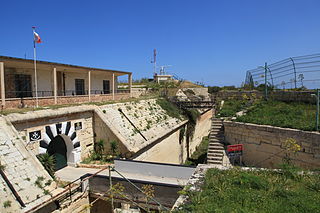
Fort Madalena, also known as Fort Madliena, is a polygonal fort in Madliena, limits of Swieqi, Malta. It was built between 1878 and 1880 by the British as part of the Victoria Lines. The fort now falls under the responsibility of the Armed Forces of Malta and is used by the St John Rescue Corps.
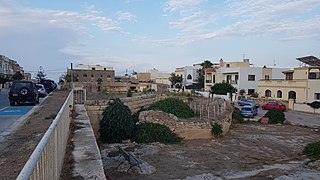
Pembroke Battery was an artillery battery in Pembroke, Malta, Malta. It was built by the British between 1897 and 1899, and most of it was demolished in the 1980s.

Fort Binġemma is a polygonal fort in the limits of Rabat, Malta. It was built between 1875 and 1878 by the British as part of the Victoria Lines. The fort has been illegally occupied by the Buttigieg family since 2009, who occasionally use it as a restaurant. It is set on a hill of around 590 feet above sea level. Previous to the building of the fort there used to be a Roman city or village.

Fort San Salvatore, also known as Fort Salvatore, is a retrenched fort in Birgu, Malta. It was built in 1724 on one of the bastions of the Cottonera Lines. It was used as a prisoner-of-war camp during the Greek War of Independence and World War I, and as an internment camp and kerosene depot in World War II.
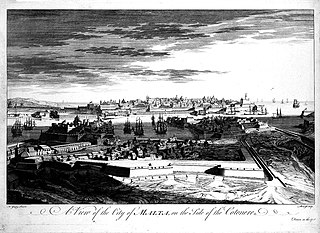
The Santa Margherita Lines, also known as the Firenzuola Lines, are a line of fortifications in Cospicua, Malta. They were built in the 17th and 18th centuries to protect the land front defences of the cities of Birgu and Senglea. A second line of fortifications, known as the Cottonera Lines, was later built around the Santa Margherita Lines, while the city of Cospicua was founded in the 18th century within the Santa Margherita and Cottonera Lines.

Fort Verdala, also known as Verdala Barracks, is a fortified barracks in Cospicua, Malta. It was built by the British in the 1850s within part of the bastions of the 17th century Santa Margherita Lines. The fort was used as a prisoner-of-war camp in both World Wars, and was later known as HMS Euroclydon. It remained in use by the British military until 1977.
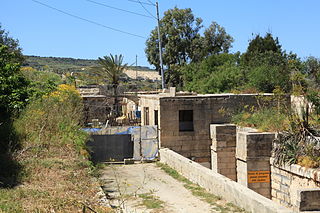
Tarġa Battery is an artillery battery on the boundary between St. Paul's Bay and Mosta, Malta. It was built in 1887 by the British as part of the Victoria Lines. The battery is now in the hands of the Mosta Local Council, who intend to restore it and open it to the public.
Pembroke Garrison is a dispersed collection of former British Army barracks built in the vicinity of Fort Pembroke, northern Malta.



















